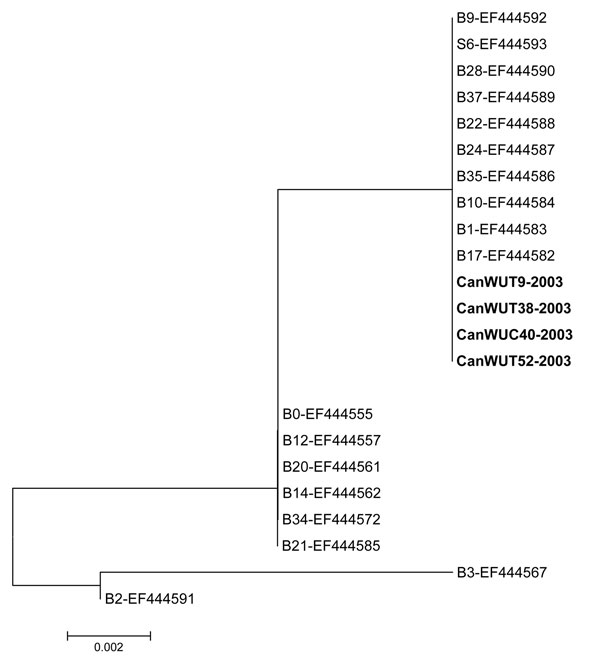Volume 13, Number 12—December 2007
Dispatch
WU Polyomavirus in Children, Canada
Figure

Figure. Phylogenetic analysis of Canadian WU polyomavirus strains CanWUT9–2003, CanWUT38–2003, CanWUC40–2003 and CanWUT52–2003 (shown in boldface), based on nucleotide sequences of the VP2 region. Multiple nucleotide sequence alignments were performed by using the ClustalW program and a phylogenetic tree was constructed with the MEGA 3.1 software using the neighbor-joining algorithm with Kimura-2 parameters (9). The analysis included WU strains previously identified from Australian and American cohorts (7) i.e., B9, S6, B28, B37, B22, B24, B35, B10, B1, B17, B0, B12, B20, B14, B34, B21, B3, and B2 (GenBank accession nos.: EF444592, EF444593, EF444590, EF444589, EF444588, EF444587, EF444586, EF444584, EF444583, EF444582, EF-444555, EF444557, EF444561, EF444562, EF444572, EF444585, EF444567, and EF444591, respectively).
References
- Cole CN. Polyomavirinae: the viruses and their replication. In: Fields BN, Knipe DM, Howley PM, editors. Fundamental virology, 3rd ed. Philadelphia: Lippincott, Williams & Wilkins; 1996. p. 917–46.
- Stewart SE, Eddy BE, Borgese NG. Neoplasms in mice inoculated with a tumour agent carried in tissue culture. J Natl Cancer Inst. 1958;20:1223–43.PubMedGoogle Scholar
- Sweet BH, Hilleman MR. The vacuolating virus, SV40. Proc Soc Exp Biol Med. 1960;105:420–7.PubMedGoogle Scholar
- Gardner SD, Field AM, Coleman DV, Hulme B. New human papovavirus (B.K.) isolated from urine after renal transplantation. Lancet. 1971;1:1253–7. DOIPubMedGoogle Scholar
- Padgett BL, Walker DL, Zurhein GM, Eckorade RJ, Dessel BH. Cultivation of papova-like virus from human brain with progressive multifocal leucoencephalopathy. Lancet. 1971;1:1257–60. DOIPubMedGoogle Scholar
- Allander T, Andreasson K, Gupta S, Bjerkner M, Bogdanovic G, Persson MA, Identification of a third human polyomavirus. J Virol. 2007;81:4130–7. DOIPubMedGoogle Scholar
- Gaynor AM, Nissen MD, Whiley DM, McKay IM, Lambert SB, Wu G, Identification of a novel polyomavirus from patients with acute respiratory tract infections. PLoS Pathog. 2007;3:e64. DOIPubMedGoogle Scholar
- Boivin G, De Serres G, Cote S, Gilca R, Abed Y, Rochette L, Human metapneumovirus infections in hospitalized children. Emerg Infect Dis. 2003;9:634–40.PubMedGoogle Scholar
- Kumar S, Tamura K, Nei M. MEGA3: Integrated software for Molecular Evolutionary Genetics Analysis and sequence alignment. Brief Bioinform. 2004;5:150–63. DOIPubMedGoogle Scholar